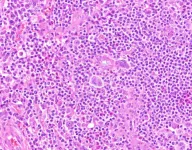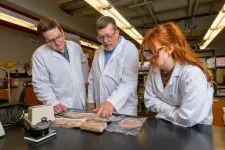(Press-News.org)
A team of researchers from the Keck School of Medicine of USC found that exposure to a mixture of synthetic chemicals found widely in the environment alters several critical biological processes, including the metabolism of fats and amino acids, in both children and young adults. The disruption of these biological processes is connected to an increased risk of a very broad range of diseases, including developmental disorders, cardiovascular disease, metabolic disease and many types of cancer.
Known as per- and polyfluoroalkyl substances, or PFAS, these man-made chemicals are used in a wide range of consumer and industrial products. PFAS are sometimes called “forever chemicals” because they break down very slowly and accumulate in the environment and human tissue.
Although individual PFAS are known to increase the risk of several types of disease, this study, published February 22 in Environmental Health Perspectives, is the first to evaluate which biological processes are altered by exposure to a combination of multiple PFAS, which is important because most people carry a mixture of the chemicals in their blood.
“Our findings were surprising and have broad implications for policy makers trying to mitigate risk,” said Jesse A. Goodrich, PhD, assistant professor of population and public health sciences and lead author of the study. “We found that exposure to a combination of PFAS not only disrupted lipid and amino acid metabolism but also altered thyroid hormone function.”
A first of its kind research project
To understand the effects that the mixture of PFAs has in the body, the team used blood samples collected from 312 adolescents who participated in the Study of Latino Adolescents at Risk and 137 children from the Southern California Children’s Health Study. They found that all the children and adolescents had a mixture of several common PFAS in their blood including PFOS, PFHxS, PFHpS, PFOA and PFNA. More than 98% of the participants also had PFDA in their blood.
The researchers also measured thousands of naturally occurring chemicals in blood and, using a biostatistical method they developed, they identified how exposure to multiple different PFAS impacted each of these naturally occurring chemicals. This information helped the researchers determine that PFAS exposure altered the way the body metabolized lipids and amino acids as well as the levels of thyroid hormone, an important determinant of metabolic rates.
The researchers focused on children and young adults because they are going through critical stages of development that may make them more susceptible to the negative health effects of PFAS exposure. It is also a time when many serious diseases that manifest in adults begin to take root. The researchers added that these results are consistent with earlier studies that showed exposure to individual PFAS in childhood was associated with dysregulated lipid and fatty acid metabolism, which can increase the risk of metabolic disorders and cardiovascular disease later in life.
One finding that stood out, according to Goodrich, was the fact that the PFAS exposure had an effect on thyroid hormone function, which has a critical role in growth and metabolism. Because of this, changes in thyroid hormones play an important role in child development during puberty, which can have important effects on a range of diseases later in life, including diabetes, cardiovascular disease and cancer.
Important public health consideration
Another important finding was the fact that exposure to a mixture of PFAS, rather than a single chemical of this type, drove the disruption of these biological processes. This finding was consistent across the two cohorts, even though they had different levels of PFAS exposure.
Almost all people in the U.S. have detectable levels of several PFAS, which are in a wide variety of products including waterproof clothing and food packaging, in their blood. An estimated 200 million people in the U.S. have drinking water with PFAS levels that are considerably higher than the levels recommended by the U.S. Environmental Protection Agency in 2022.
Some manufacturers have phased out the use of individual PFAS, but the authors of this study conclude that this research shows why it may be more important to regulate PFAS as a class of chemicals.
“We are really only beginning to understand the range of effects that these chemicals have on human health,” said Leda Chatzi, MD, PhD, professor of population and public health sciences and another of the study’s authors. “While current interventions have focused on phasing out the use of individual PFAS, such as PFOS and PFOA, this research shows why the focus should be on reducing exposure to all PFAS chemicals.”
About the study
Additional authors of the study include Jingxuan He, Brittney O. Baumert, Zhanghua Chen, Sarah Rock, Hongxu Wang, Frank D. Gilliland, David V. Conti, and Michael Goran of the Keck School of Medicine of USC; Douglas I. Walker, Dean P. Jones and Xin Hu of Emory University; Xiangping Lin, Damaskini Valvi, and Zoe Coates Fuentes of the Icahn School of Medicine at Mount Sinai; Tanya L. Alderete of the University of Colorado Boulder; Kiros Berhane of Columbia University.
The researchers would like to acknowledge the source for funding this research which was provided by the National Institutes of Health/National Institute of Environmental Health Sciences (R01ES029944).
END
Eighteen cartoons have been selected as finalists in the 2023 Ethics Cartooning Competition, an annual contest sponsored by the Morgridge Institute for Research.
Participants from the University of Wisconsin-Madison and affiliated biomedical centers or institutes submitted their work, then a panel of judges selected the final cartoons for display to the public, who is invited to vote and help determine the 2023 winners.
This year’s cartoons depict a variety of research ethics topics, such as the ethics of scientific publishing, research funding and environments, questionable research practices, ...
The Boyce Thompson Institute (BTI) is delighted to announce that faculty member Fay-Wei Li has been promoted to Associate Professor on January 13. Li was evaluated on his achievements to date and likelihood of continued success in the future.
Since joining BTI in 2017, Li has developed an internationally-recognized program on seed-free plants, both in terms of genome sequencing and in making biological discoveries. He also is an excellent science communicator, with a knack for explaining the importance of scientific discoveries to a wide range of audiences.
The ...
BINGHAMTON, N.Y. – So much of modern life is spent on screens: Zoom meetings and websites, smartphones and videogames, televisions and social media. How are all those pixels and rectangles affecting how we see?
Binghamton University, State University of New York Professor of Psychology Peter Gerhardstein and doctoral candidate Nicholas Duggan explore the phenomenon in “Levels of Orientation Bias Differ Across Digital Content Categories: Implications for Visual Perception,” recently published in the journal Perception. Their paper covers the extent to which online content ...
CLEVELAND: Supported by a new $3.14 million grant from the National Institutes of Health to Cleveland Clinic, researchers are using an emerging technology known as “digital twins” to better understand healthcare disparities based on where someone lives. Researchers from Cleveland Clinic and MetroHealth aim to use this information to develop strategies designed to reduce these disparities in health outcomes.
The research team, led by Jarrod Dalton, Ph.D., of Cleveland Clinic, and Adam Perzynski, Ph.D., of MetroHealth, ...
(MIAMI, FL, FEB. 21, 2023) – To create the most effective, personalized treatment plans for patients with Hodgkin lymphoma or other cancers, scientists and clinicians need the clearest picture of the genetic changes leading to the cancer’s development. That picture, say scientists at Sylvester Comprehensive Cancer Center in the University of Miami Miller School of Medicine, comes into much better focus when whole genome sequencing – rather than the current standard, exome sequencing – is used to identify changes driving the cancer.
Exome sequencing, which reads only protein-coding genes, can detect some specific mutations and other variants that propel cancers, ...
Written by Kay Ledbetter, 806-547-0002, skledbetter@ag.tamu.edu
Imagine your favorite cured meat like beef jerky, pepperoni or bacon without any added sodium nitrite from any source currently necessary for color and shelf life. Wes Osburn, Ph.D., is doing exactly that.
At center, Wes Osburn, Ph.D., Texas A&M University meat scientist, is working in his lab with students Tanner Wright and Arlie Reeves on a new no nitrite-added cured meat system. (Texas A&M AgriLife photo ...
Eurasian spruce bark beetles (Ips typographus) burrow into the bark of Norway spruce (Picea abies) trees where they mate and lay their eggs. Major outbreaks in Europe have decimated millions of hectares of conifer forests. The beetles preferentially attack trees that are already infected with symbiotic fungi (such as Grosmannia penicillata), which is thought to weaken host trees and break down their chemical defenses, allowing the beetles to successfully develop in the bark.
To investigate the chemical signals ...
The mass outbreaks of bark beetles observed in recent years have caused shocking amounts of forest damage throughout Germany. As reported by the Federal Statistical Office in July 2022, more than 80% of the trees that had to be felled in the previous year were damaged by insects. The damaged timber felled due to insect damage amounted to more than 40 million cubic meters. One of the main pests is the European spruce beetle Ips typographus. In the Thuringian Forest and the Harz Mountains, for example, the beetle, which is only a few millimeters long, encountered spruce monocultures that had already been weakened by high temperatures and extended ...
Takeaki Ozawa and his team from the University of Tokyo reveal the metabolic reactions upon activating an enzyme called Akt2. In doing so, they reveal the inner workings of insulin-regulated metabolism. The findings lead the way for Akt2-targeting therapeutics for diabetes and metabolic disorders.
It takes energy to do anything—even to exist. You can metabolize food to convert glucose into energy: thanks to many cascades of molecular reactions within your cells. As soon as you eat, your pancreas secretes insulin hormone, which starts ...
SAN FRANCISCO, CA—February 21, 2023—Of all the known genetic risk factors for late-onset Alzheimer’s disease, the strongest is a gene for the protein called ApoE4. People with one copy of this gene are 3.5 times more likely, on average, to develop Alzheimer’s than others, and those with two copies face a 12-fold increased risk. However, exactly how ApoE4 boosts the risk of Alzheimer’s remains unclear.
Multiple types of cells in the brain make ApoE4—some of it is produced by neurons, but other brain cells called glia make it in higher quantities. For that reason, most prior research on this protein has focused on ...






